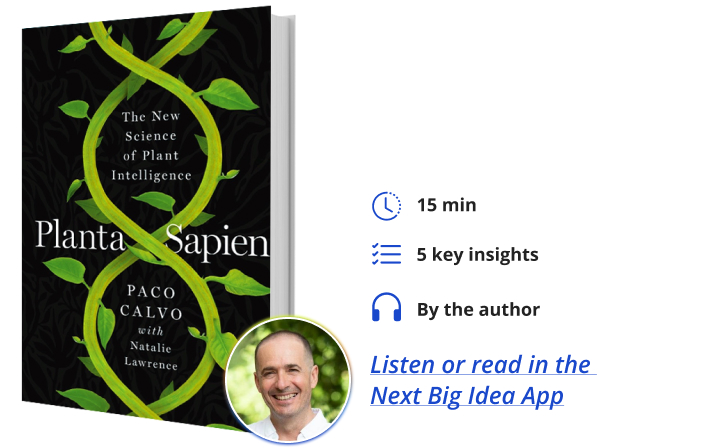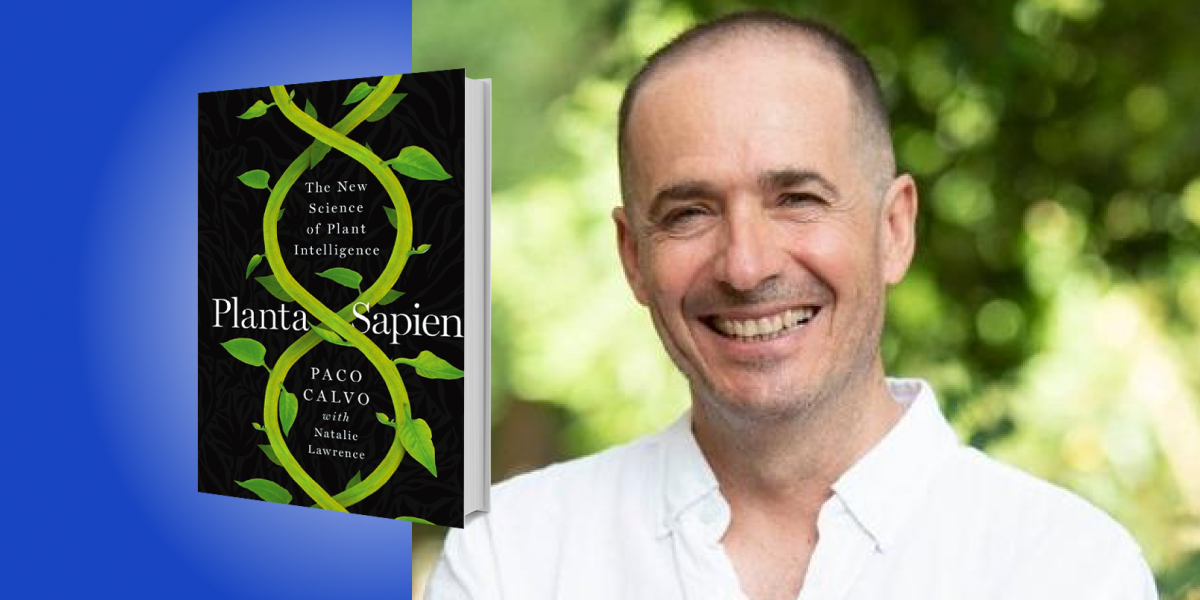Paco Calvo is a Professor of Logic and Philosophy of Science in the Department of Philosophy at the University of Murcia. He directs the MINT (Minimum Intelligence Laboratory) Lab, which specializes in the philosophy of cognitive science and plant neurobiology.
Natalie Lawrence is an author, illustrator, and biology teacher with a background in Zoology. She has an MCantab in Natural Sciences and an MSc and Ph.D. in History and Philosophy of Science from the University of Cambridge.
Below, Paco and Natalie share 5 key insights from their new book, Planta Sapiens: The New Science of Plant Intelligence. Listen to the audio version—read by Paco—in the Next Big Idea App.

1. You can put a plant to sleep.
Plants can be knocked out using the very same drug that your vet might use to put your pet to sleep. Demonstrations of “plants under anesthesia” have been carried out a number of times, and those watching could hardly believe their eyes.
You can use a Venus flytrap, a plant that snap-shuts when touched, or any plant with reactions that can be seen by the human eye. If you put one of these plants under a glass bell jar together with some cotton soaked in anesthetic, the plant will slide gently into sleep. To spice things up a bit, arrange surface electrodes on the Venus fly trap such that you can see the electrical activity in the excitable cell membranes on the big screen. In the beginning, the electrical signal will show spikes of voltage every time it’s touched. After a while, once the plant is fully anesthetized, if you touch it, it will remain completely still, a flat line: no electrical activity whatsoever. Just as you would see a reduction in electrical signaling activity in an animal’s nervous system.
This kind of experiment provides the perfect blank slate from which to begin to view plants in an entirely new way. It’s just the beginning. Take sleep; do plants sleep? Most people would assume we’re talking metaphorically but when you think about it, all life needs to take some time off. Being alive takes its toll, a good night’s sleep gives the opportunity for DNA repair, and plants use sleep for the same reasons animals do.
The mechanisms controlling sleep are similar too. Have you seen legumes, say, a climbing bean, folding its leaves at night? They are synthesizing their own melatonin. Some of us go to the pharmacy to buy some melatonin tablets to ease into sleep, or we might have taken a melatonin pill to counteract the effects of jet lag. Plants can be jet lagged too but, rather than going to the pharmacy, they biosynthesize their own melatonin that helps them regulate their circadian rhythms, just as we do with our internal circadian clocks under the cycles of day and night.
If plants had to rely 100 percent on knee-jerk responses to their environment there would be unhelpful delays, such as being awake for a period after the sun was down, or being far too slow to get moving in the morning. If your levels of melatonin oscillate, this can come in handy: it will allow plants to predict what state they should be in at any point in time.
2. Plants can predict the future.
Why wouldn’t plants be able to predict the future, just like animals do? It is true that animal and plant behavior differ substantially from one another. Animals, generally, speak and move quickly; plants, on the other hand, are rooted; they can’t just walk off. If they are going to keep up with whatever is going on, they have to ‘move’ somewhat more creatively by growing. Being sessile, they can’t afford to be stupid, or not be able to anticipate what’s going to happen next. After all, they cannot possibly flee the way animals do but, they are not merely passive organisms taking life as it comes.
“Plants have to plan ahead to achieve goals, and to do so they need to integrate vast pools of data.”
To survive, plants must be able to sense many different sources of important information. Examples are light quality and direction: they’ve got to be able to distinguish day length and annual variations. They require mechanisms to assess the number of days below or between certain temperatures. They need to know which way is up and whether there is something or someone in the way—and use it to control the way they grow. They need to tell and distinguish all angles to sense and accommodate branch weight.
Roots have to grow in a way that predicts where resources will be. Shoots turn, grow, bud, and flower guided by predictions about where there will be sunlight, how the seasons will change, or whether there will be enough minerals and nutrients to support growth in the future. Flowers can even time their pollen production and presentation to fit the times when pollinators are likely to visit by extrapolating from past experience.
Plants are constantly swaying their organs, responding to uncertainties about the structure of the soil, predators, and competition for sunlight in the vicinity. They must tell if a vibration belongs to a munching caterpillar whose chewing frequencies can elicit plant defense strategies. They need to know about bees buzzing to increase nectar release accordingly for showers of pollen. Plants have to plan ahead to achieve goals, and to do so they need to integrate vast pools of data. They need to engage with their surroundings adaptively and proactively, and they need to think about the future. They just couldn’t afford to do otherwise.
To do all of this, they rely, at least in part, on some complex information-processing machinery to integrate all of these inputs and make sense of them. This machinery is in some ways akin to the nervous system of animals, able to perform similar kinds of functions. Electrical signals flow throughout the whole plant body, permitting the integration and transmission of information across the plant body, from root to shoot. They are in some ways the “nerves” of the plant body.
3. You can use your cell phone to reveal what your plant is up to.
Mulling over plant smarts is not an idle intellectual exercise. You can actually see it; you can observe plant behavior. There have been many efforts dedicated to observing plant behaviors, all the way from Darwin’s naked-eye observations to today’s cutting-edge techniques of observation.
I myself began taking time-lapse photograph sequences of wild vines growing in my orchard in the south of Spain. I actually didn’t do anything to the vines’ environment, added no poles or complex experimental set-ups, I simply took time-lapse footage of them as they grew around looking for supports or as they tangled themselves across my olive and orange trees. Eventually, this time-lapse project made its way into the lab, through which we started to discover all sorts of cool stuff. You can do so too! You don’t need to buy expensive gear or have a lab; you can do it at home. Many apps will allow you to do so from your cell phone.
“From a snaking, exploratory growth, it will change to a direct approach to its target.”
Take a dodder plant, a species that parasitizes other plants. If you record it approaching, say, a tomato plant to suck its nutrients out, the pattern of movement will change. From a snaking, exploratory growth, it will change to a direct approach to its target. In fact, if the dodder had started to grow towards a host which seems of low quality (a wheat plant, maybe, which doesn’t offer much for the dodder), and senses the more appetizing tomato plant nearby, it will change direction and head for the more appealing option. It will always choose the tomato plant and will grow much faster towards it.
4. NASA cares about plants.
You may think space agencies care for plants to feed the dwellers of future settlements on Mars or the moon. But there’s another more intriguing aspect. Think of a rover moving around Mars and sampling the terrain, cruising around while receiving commands sent from Earth over 30 million miles away. Whilst exploring need not entail mobility, perhaps we could inspire our future rovers, not in the concept of animal locomotion, but in plant growth, with no need to wheel-drive across the terrain at all. Why do we need to travel across a landscape in search of targets to inspect and sample? Why not grow instead? In fact, back in 2017, a major funding agency emailed me exploring the idea of funding research into ‘plant intelligence’ which might eventually lead to innovations in robotics and AI.
Why is this? Well, MIT’s robot “cheetah” might be able to do a backflip, but if it encounters terrain that is uneven, it might get stuck. Working on obstacles within the parameters of traditional robotic design will always have limitations. But if we think about how vines use their tendrils to reach out for their targets, we can play a whole new robotic game. Robots may learn to grow through space rather than move through it, climbing and grasping rather than locomoting. In a nutshell, if you are at location A and need to reach location B, one way to do so is simply to grow from A to B. In other words: you can reach B without leaving A. This plant-inspired mode of being allows you to be in multiple places at once, collecting a network of information just as a plant might do. Inspiring our rovers with plant-like ways of getting around could allow us not to find a different solution to an existing problem, but rather to redefine the nature of the problem altogether. Put bluntly, you don’t worry about getting stuck in cracks if you don’t have wheels! We can begin to design robots that solve problems with diffused and decentralized forms of intelligence, as plants themselves do.
5. What if plants could suffer or feel pain?
Assuming by default that plants cannot feel or suffer is extremely convenient for the human purpose of guilt-free plant consumption, but what if plants were like “locked-in syndrome” patients? What if they happened to have their own internal experiences that are just currently inaccessible to us? If plants actually have their own interior lives, then, Houston, we have a problem. This might be a huge problem. Delving into the inner lives of plants has the potential to offer revelations that will drastically shift the way we see the world and how we choose to exist in it. The very possibility that plants have subjective experiences has profound implications. Those thinking about such issues already are always the first to realize this. Vegans and vegetarians always raise their hands first at my talks, asking: If plants are sentient creatures, now what?
“One way or another, pain, as an indicator of damage or danger, is extremely useful from an evolutionary perspective.”
We cannot possibly ignore such a possibility. Many of the chemicals that control behavior and emotions in humans and other animals such as serotonin, dopamine, and adrenaline are also synthesized or have analogs in plants. Being expensive to produce, it would make no evolutionary sense to manufacture such substances without purpose.
Some of these chemicals are only produced in situations when plants are stressed or injured. Plants make many substances that have pain-killing or anesthetic effects, such as ethylene. We certainly don’t know that these molecules act as painkillers in plants, but given that they are created in stressful situations, there is reason to believe that they serve to relieve suffering. From an evolutionary standpoint, the ability to perceive pain or to suffer in some way is essential. In a dangerous and constantly shifting world, organisms must be able to respond to negative events.
One way or another, pain, as an indicator of damage or danger, is extremely useful from an evolutionary perspective. Plants show actively avoidant behaviors, they have “nervous”-like systems that can coordinate responses through their bodies, and pain should be no less useful in the evolutionary history of rooted organisms than for those who can run away from it.
More generally, we need to consider the evolutionary importance of “feelings” beyond being an abstract distinguishing feature of humanity. Emotion and emotional behaviors might have evolved across the tree of life for very good reasons. They give the capacity to make rapid, prioritized decisions in response to the demands of a dangerous environment. We are actually far more driven by emotions than we like to think—they are powerful guides! If it makes sense to animals to “trust their gut,” it might as well pay off for plants to “trust their gut” too. It’s just unfortunate that our instincts are to ignore plants as background greenery because they don’t fit into our immediate, fast-paced attention spans. However, perhaps it’s time to rethink how we understand ourselves.
To listen to the audio version read by author Paco Calvo, download the Next Big Idea App today:






























